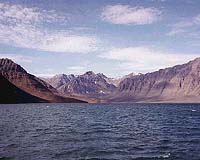| . |  |
. |
Newark DE (SPX) Nov 03, 2010 As the ice-capped Arctic Ocean warms, ship traffic will increase at the top of the world. And if the sea ice continues to decline, a new route connecting international trading partners may emerge - but not without significant repercussions to climate, according to a U.S. and Canadian research team that includes a University of Delaware scientist. Growing Arctic ship traffic will bring with it air pollution that has the potential to accelerate climate change in the world's northern reaches. And it's more than a greenhouse gas problem - engine exhaust particles could increase warming by some 17-78 percent, the researchers say. James J. Corbett, professor of marine science and policy at UD, is a lead author of the first geospatial approach to evaluating the potential impacts of shipping on Arctic climate. The study, "Arctic Shipping Emissions Inventories and Future Scenarios," is published in Atmospheric Chemistry and Physics. Corbett's coauthors include Daniel A. Lack, from the National Oceanic and Atmospheric Administration (NOAA) Earth System Research Laboratory in Boulder, Colo.; James J. Winebrake, of the Rochester Institute of Technology; Susie Harder of Transport Canada in Vancouver, British Columbia; Jordan A. Silberman of GIS Consulting in Unionville, Pa.; and Maya Gold of the Canadian Coast Guard in Ottawa, Ontario. "One of the most potent 'short-lived climate forcers' in diesel emissions is black carbon, or soot," says Corbett, who is on the faculty of UD's College of Earth, Ocean, and Environment. "Ships operating in or near the Arctic use advanced diesel engines that release black carbon into one of the most sensitive regions for climate change." Produced by ships from the incomplete burning of marine fuel, these tiny particles of carbon act like 'heaters' because they absorb sunlight - both directly from the sun, and reflected from the surface of snow and ice. Other particles released by ship engines also rank high among important short-lived climate forcers, and this study estimates their combined global warming impact potential. To better understand the potential impact of black carbon and other ship pollutants on climate, including carbon dioxide, methane and ozone, the research team produced high-resolution (5-kilometer-by-5-kilometer) scenarios that account for growth in shipping in the region through 2050, and also outline potential new Arctic shipping routes. Among the research team's most significant findings: + Global warming potential in 2030 in the high-growth scenario suggests that short-lived forcing of ~4.5 gigatons of black carbon from Arctic shipping may increase the global warming potential due to ships' carbon dioxide emissions (~42,000 gigagrams) by some 17-78 percent. + Ship traffic diverting from current routes to new routes through the Arctic is projected to reach 2 percent of global traffic by 2030 and to 5 percent in 2050. In comparison, shipping volumes through the Suez and Panama canals currently account for about 4 percent and 8 percent of global trade volume, respectively. + A Northwest Passage and Northeast Passage through the Arctic Ocean would provide a distance savings of about 25 percent and 50 percent, respectively, with coincident time and fuel savings. However, the team says tradeoffs from the short-lived climate forcing impacts must be studied. + To calculate possible benefits of policy action, the study provides "maximum feasible reduction scenarios" that take into account the incorporation of emissions control technologies such as seawater scrubbers that absorb sulfur dioxide emitted during the burning of diesel fuel. Their scenario shows that with controls, the amount of Arctic black carbon from shipping can be reduced in the near term and held nearly constant through 2050. "To understand the value of addressing short-lived climate forcers from shipping, you need to know the impacts of these emissions, the feasibility and availability of technologies that could be put in place to reduce these impacts, and then engage the policy-making community to debate the evidence and agree on a plan," Corbett notes. "Our hope is that this study will enable better communication of emerging science with policy makers and aid the eight Arctic Council nations with climate policy." Corbett also has led recent studies to determine the global health effects of shipping, and more recently, a comparison of the daily release of oil from the Deepwater Horizon oil spill and Americans' daily energy use.
Share This Article With Planet Earth
Related Links - Beyond the Ice Age
 Whales Help Researchers Take Winter Temperature Of Greenland Coastal Waters
Whales Help Researchers Take Winter Temperature Of Greenland Coastal WatersWashington DC (SPX) Oct 28, 2010 Scientists using sensors attached to a type of Arctic whale known for its unicorn-horn-like tooth have detected continued warming of the southern Baffin Bay off West Greenland. The temperatures of the waters have continued to rise since wintertime ocean temperatures were last effectively measured there in the early 2000s, the researchers reported October 23 in the Journal of Geophysical Re ... read more |
|
| The content herein, unless otherwise known to be public domain, are Copyright 1995-2010 - SpaceDaily. AFP and UPI Wire Stories are copyright Agence France-Presse and United Press International. ESA Portal Reports are copyright European Space Agency. All NASA sourced material is public domain. Additional copyrights may apply in whole or part to other bona fide parties. Advertising does not imply endorsement,agreement or approval of any opinions, statements or information provided by SpaceDaily on any Web page published or hosted by SpaceDaily. Privacy Statement |